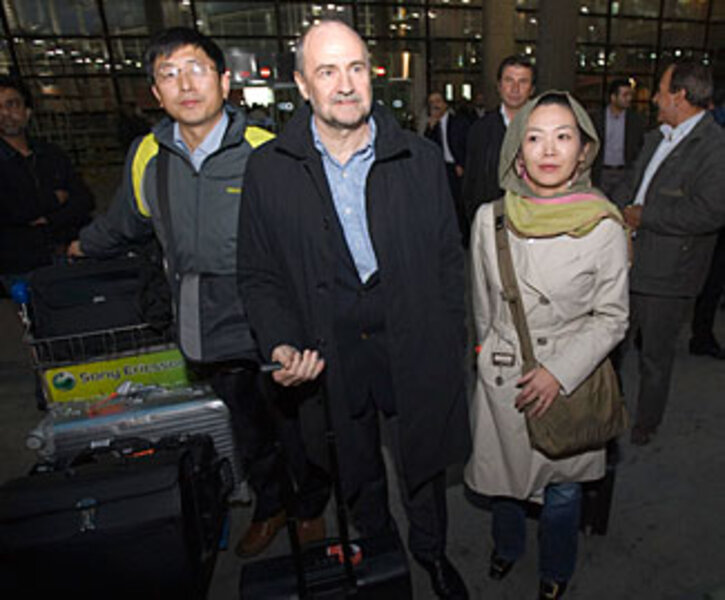UN nuclear watchdog: Can’t rule out other Iran enrichment sites
Loading...
| Istanbul, Turkey
In its first report on Iran's nuclear program since the revelation of a second uranium enrichment facility near Qom in September, the International Atomic Energy Agency (IAEA) said Monday it could not rule out other hidden nuclear sites in Iran.
Iran's belated declaration in September after years of construction work "reduces the level of confidence in the absence of other nuclear facilities in Iran which [have] not been declared," the IAEA said in its restricted report for members, which was leaked to the media.
IAEA inspectors were given full access to the facility late last month and found no centrifuges. Iran has denied any other undeclared sites. But the UN nuclear watchdog remained concerned enough to ask Iran to explicitly state there are no more hidden nuclear sites.
"The [first] answer was apparently not satisfactory," says David Albright, the head of the Institute for Science and International Security in Washington, which frequently is the first to publish IAEA reports. "That's really what their request for a written answer is; Iran's credibility has been seriously damaged by the existence of this site, and their oral answers are not perceived as honest or complete."
In a Nov. 6 letter, the IAEA asked Iran "to confirm that it had not taken a decision to construct, or to authorize construction of, any other nuclear facility which had not been declared to the Agency." Iran has not responded yet to that request.
'Advanced' construction at Fordo
IAEA inspectors found no centrifuges in the facility near Qom, known as Fordo or Fordow. But they found the plant, which Iran says is due to be ready in 2011, to be "at an advanced state of construction," with an array of piping and electrical cables and mounting gear installed.
Iran has repeatedly asserted that it was only required to disclose the Fordo site six months before the introduction of nuclear material, but that interpretation of its obligations is not shared by the IAEA.
The IAEA says that revised rules Iran agreed to in 2003 require it to declare all projects to the agency at the moment they are authorized.
While Iran claimed it only began work at the Fordo facility in the second half of 2007, IAEA monitors informed Tehran that commercial satellite imagery showed work began in 2002, stopped in 2004 and then resumed in 2006.
Drop in centrifuge use
Even as Iran weighs a deal with leading powers to exchange the bulk of its low-enriched uranium (LEU) for much-needed fuel for a medical reactor, the IAEA reported that Iran has not expanded its uranium enrichment program since its last quarterly report in August.
While Iran has installed a total of 8,692 centrifuges, only 3,936 were in operation as of Nov. 2 – a drop of 650 from August. The new Fordo facility at Qom is meant to house just 3,000 centrifuges, and in correspondence with the IAEA Iran called it a "contingency enrichment plant" built because the main plant at Natanz, designed for 50,000 centrifuges, "was among targets threatened with military attacks."
According to the IAEA report, Iran permitted two unannounced inspections at Natanz, for a total of 31 since early 2007. Agency monitors found the Fordo facility to be consistent with "extensive information" provided by member states, but said that Iran's explanation about the purpose of the facility and the chronology of its design and construction "requires further clarification."
The report also stated that Iran had not provided new information about alleged studies for weaponization – documents provided by intelligence agencies of weapon-related designs that Iran says were fabricated -- in over a year.
Ahmadinejad trumpets 'defeat' of West
Just before the IAEA report was released to member states on Monday, President Mahmoud Ahmadinejad said Iran had "defeated" all those who wanted to deprive Iran of nuclear technology.
"Enemies have politicized the nuclear issue using all of their abilities to try to make the Iranian nation surrender, but they have all been defeated," Ahmadinejad said, according to the official state broadcaster.
Ahmadinejad – who began a second term in August, after a contested June election brought hundreds of thousands of Iranians onto the street in protests that turned violent – said that Iran's nuclear rights were "non-negotiable."
The Iranian president said that "cooperation with Iran is in the West's interest" but that increased pressure would only make Iran "more powerful and advanced," according to the Associated Press.
Some speculate that if Iran and the permanent five members of the UN Security Council plus Germany – the negotiating group with Iran known as the P5+1 – do not agree to a deal, then Iran might decide itself to try to provide the 20 percent enriched uranium fuel it needs for medical purposes. That would be a substantial increase from the 3.5 percent enriched uranium Iran is currently producing to one day make nuclear fuel, but still far from the 90 percent necessary to make a bomb.
Iran is currently under three sets of UN Security Council sanctions for failing to suspend uranium enrichment, but the P5+1 deal tacitly recognizes that Iran has made significant strides in enrichment technology in the past four years.





